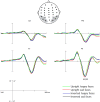Classification of Emotional Expressions Is Affected by Inversion: Behavioral and Electrophysiological Evidence
- PMID: 28232793
- PMCID: PMC5298963
- DOI: 10.3389/fnbeh.2017.00021
Classification of Emotional Expressions Is Affected by Inversion: Behavioral and Electrophysiological Evidence
Abstract
It has been shown that emotionally positive facial expressions are recognized substantially faster than emotionally negative facial expressions, the positive classification advantage (PCA). In this experiment we explored the involvement of configural computations while processing positive and negative faces in an expression categorization task using artificial faces. Analyzing the reaction times (RTs), we found that happy faces were categorized more quickly than sad faces (PCA) and this effect disappeared for inverted faces. Event-related potentials (ERPs) data showed that the face-sensitive N170 component was larger for sad than for happy faces only at upright condition and that face inversion significantly enhanced N170 amplitudes only for happy faces. Moreover, the happy faces elicited shorter N170 latency than did the sad faces, whereas for inverted condition the N170 latency did not differ between happy and sad faces. Finally, the significant positive correlation between the RTs and the latency of the N170 was not found for N170 amplitudes. Because the configural computation was task-irrelevant in the present study, these behavioral and ERP data indicated that one of the sources of PCA is the configural analysis applied by default while categorizing facial emotions.
Keywords: N170; expression; face classification; face inversion.
Figures
Similar articles
-
Categorization of Emotional Faces in Insomnia Disorder.Front Neurol. 2020 Jun 19;11:569. doi: 10.3389/fneur.2020.00569. eCollection 2020. Front Neurol. 2020. PMID: 32636799 Free PMC article.
-
Unconscious Processing of Facial Expressions in Individuals with Internet Gaming Disorder.Front Psychol. 2017 Jun 23;8:1059. doi: 10.3389/fpsyg.2017.01059. eCollection 2017. Front Psychol. 2017. PMID: 28690578 Free PMC article.
-
Mapping the time course of the positive classification advantage: an ERP study.Cogn Affect Behav Neurosci. 2013 Sep;13(3):491-500. doi: 10.3758/s13415-013-0158-6. Cogn Affect Behav Neurosci. 2013. PMID: 23504806
-
Cognitive Bias by Gender Interaction on N170 Response to Emotional Facial Expressions in Major and Minor Depression.Brain Topogr. 2016 Mar;29(2):232-42. doi: 10.1007/s10548-015-0444-4. Epub 2015 Aug 4. Brain Topogr. 2016. PMID: 26239020
-
N170 sensitivity to facial expression: A meta-analysis.Neurosci Biobehav Rev. 2015 Aug;55:498-509. doi: 10.1016/j.neubiorev.2015.06.002. Epub 2015 Jun 9. Neurosci Biobehav Rev. 2015. PMID: 26067902 Review.
Cited by
-
Prioritized Identification of Fearful Eyes during the Attentional Blink Is Not Automatic.Brain Sci. 2023 Sep 29;13(10):1392. doi: 10.3390/brainsci13101392. Brain Sci. 2023. PMID: 37891761 Free PMC article.
-
Facial Emotion Recognition Deficit in Children with Moderate/Severe Obstructive Sleep Apnea.Brain Sci. 2022 Dec 8;12(12):1688. doi: 10.3390/brainsci12121688. Brain Sci. 2022. PMID: 36552148 Free PMC article.
-
Categorization of Emotional Faces in Insomnia Disorder.Front Neurol. 2020 Jun 19;11:569. doi: 10.3389/fneur.2020.00569. eCollection 2020. Front Neurol. 2020. PMID: 32636799 Free PMC article.
-
The Effect of High-Definition Transcranial Direct Current Stimulation of the Right Inferior Frontal Gyrus on Empathy in Healthy Individuals.Front Hum Neurosci. 2018 Nov 12;12:446. doi: 10.3389/fnhum.2018.00446. eCollection 2018. Front Hum Neurosci. 2018. PMID: 30483081 Free PMC article.
-
Positive Classification Advantage of Categorizing Emotional Faces in Patients With Major Depressive Disorder.Front Psychol. 2022 Jul 1;13:734405. doi: 10.3389/fpsyg.2022.734405. eCollection 2022. Front Psychol. 2022. PMID: 35846609 Free PMC article.
References
LinkOut - more resources
Full Text Sources
Other Literature Sources



